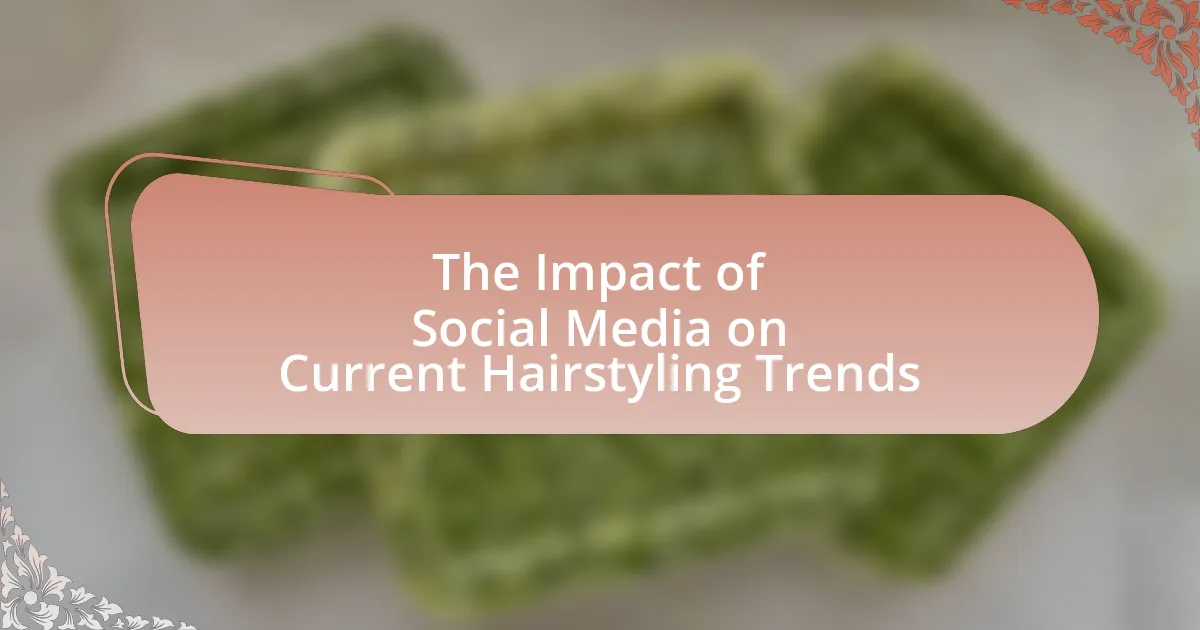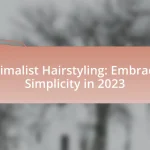The article examines the significant impact of social media on current hairstyling trends, highlighting how platforms like Instagram and TikTok facilitate the rapid dissemination of styles and techniques. It discusses the role of influencers in shaping consumer preferences, with 70% of consumers discovering new hairstyles through social media. The article also explores how social media democratizes hairstyling trends, encourages experimentation, and influences the marketing strategies of hairstylists. Additionally, it addresses the psychological factors driving engagement with hairstyling content and the implications for hairstyling professionals in adapting to evolving trends.
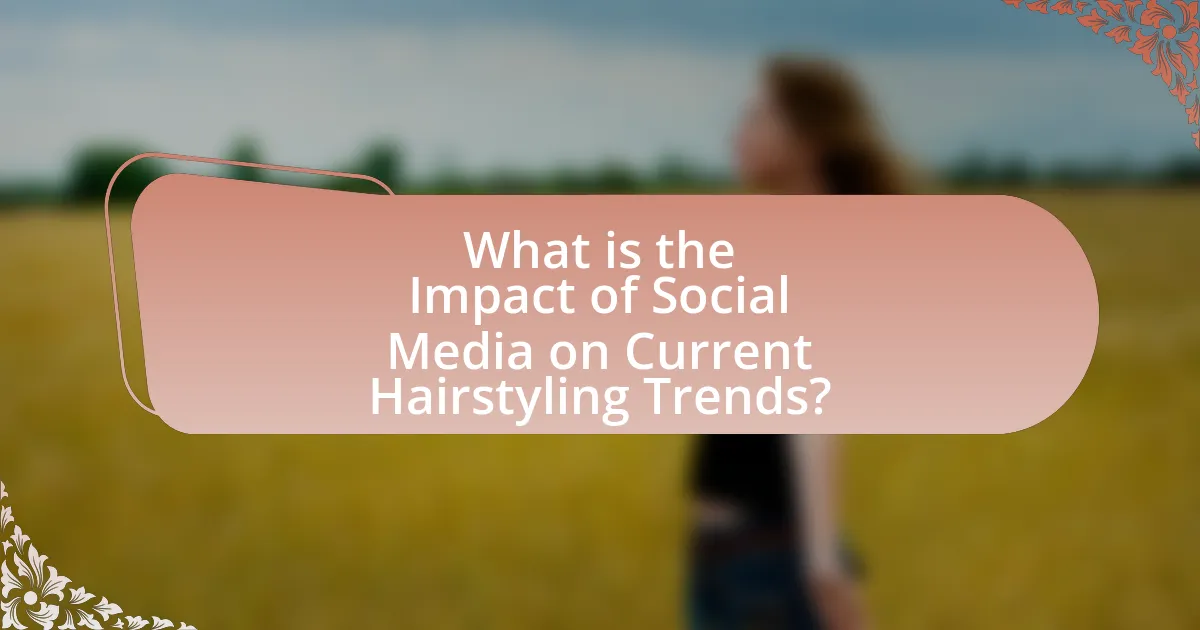
What is the Impact of Social Media on Current Hairstyling Trends?
Social media significantly influences current hairstyling trends by facilitating rapid dissemination of styles and techniques among users. Platforms like Instagram and TikTok allow hairstylists and influencers to showcase their work, leading to viral trends such as curtain bangs or pastel hair colors. According to a survey by the Professional Beauty Association, 70% of consumers reported discovering new hairstyles through social media, highlighting its role as a primary source of inspiration. This immediate access to diverse styles encourages experimentation and personalization, shaping consumer preferences and driving demand for specific trends in salons.
How has social media changed the way we perceive hairstyling?
Social media has transformed the perception of hairstyling by democratizing access to trends and styles, allowing individuals to discover and share diverse looks instantly. Platforms like Instagram and TikTok enable users to showcase their hairstyles, leading to the rapid spread of trends such as balayage and curtain bangs, which can gain popularity overnight. According to a survey by the Professional Beauty Association, 70% of consumers reported that social media influences their hairstyle choices, highlighting its significant role in shaping public perception. This shift has also encouraged greater experimentation and personalization in hairstyling, as users feel empowered to try new looks inspired by influencers and peers.
What role do influencers play in shaping hairstyling trends?
Influencers play a significant role in shaping hairstyling trends by leveraging their large followings on social media platforms to showcase new styles and techniques. Their ability to reach and engage with diverse audiences allows them to introduce and popularize specific hairstyles, often leading to viral trends. For instance, a study by the Pew Research Center found that 72% of teenagers in the U.S. follow influencers, indicating their substantial impact on youth culture and preferences. This influence is further amplified by the visual nature of platforms like Instagram and TikTok, where hairstyling tutorials and transformations can quickly gain traction, leading to widespread adoption of new trends.
How do social media platforms facilitate trend dissemination?
Social media platforms facilitate trend dissemination by enabling rapid sharing and engagement among users. These platforms utilize algorithms that promote popular content, allowing trends to reach a wider audience quickly. For instance, Instagram’s Explore page and TikTok’s For You page showcase trending hairstyles, leading to viral challenges and widespread adoption. According to a study by the Pew Research Center, 69% of adults in the U.S. use social media, which amplifies the visibility of emerging trends. Additionally, influencers on these platforms often set trends by showcasing new hairstyles, further accelerating their spread through follower engagement and shares.
Why is social media a powerful tool for hairstyling trends?
Social media is a powerful tool for hairstyling trends because it enables rapid dissemination and sharing of visual content, allowing trends to spread quickly across diverse audiences. Platforms like Instagram and TikTok facilitate the showcasing of hairstyles through images and videos, which can reach millions of users instantly. According to a study by the Pew Research Center, 69% of adults in the U.S. use social media, making it a significant platform for influencing consumer behavior and preferences in hairstyling. Additionally, the interactive nature of social media allows users to engage with content through likes, shares, and comments, further amplifying the visibility of trending hairstyles.
What psychological factors drive engagement with hairstyling content?
Psychological factors driving engagement with hairstyling content include self-expression, social validation, and aspirational identity. Self-expression allows individuals to showcase their personality and creativity through hairstyling choices, fostering a sense of individuality. Social validation occurs when users seek approval and recognition from peers, enhancing their self-esteem through likes and comments on hairstyling posts. Aspirational identity is evident as individuals engage with content that reflects their desired self-image, often influenced by trends and influencers. Research indicates that social media platforms amplify these psychological drivers, as users are motivated to interact with content that resonates with their personal aspirations and social needs.
How does user-generated content influence hairstyling choices?
User-generated content significantly influences hairstyling choices by providing relatable and diverse examples of hairstyles that resonate with individual preferences. Social media platforms, such as Instagram and TikTok, showcase real users sharing their hairstyling experiences, which fosters a sense of community and inspiration. According to a study by the Pew Research Center, 72% of teens use social media, making it a primary source for discovering new trends. This exposure to various styles encourages users to experiment with their hair, leading to increased adoption of trending hairstyles. Additionally, user-generated content often includes tutorials and product recommendations, further guiding consumers in their hairstyling decisions.
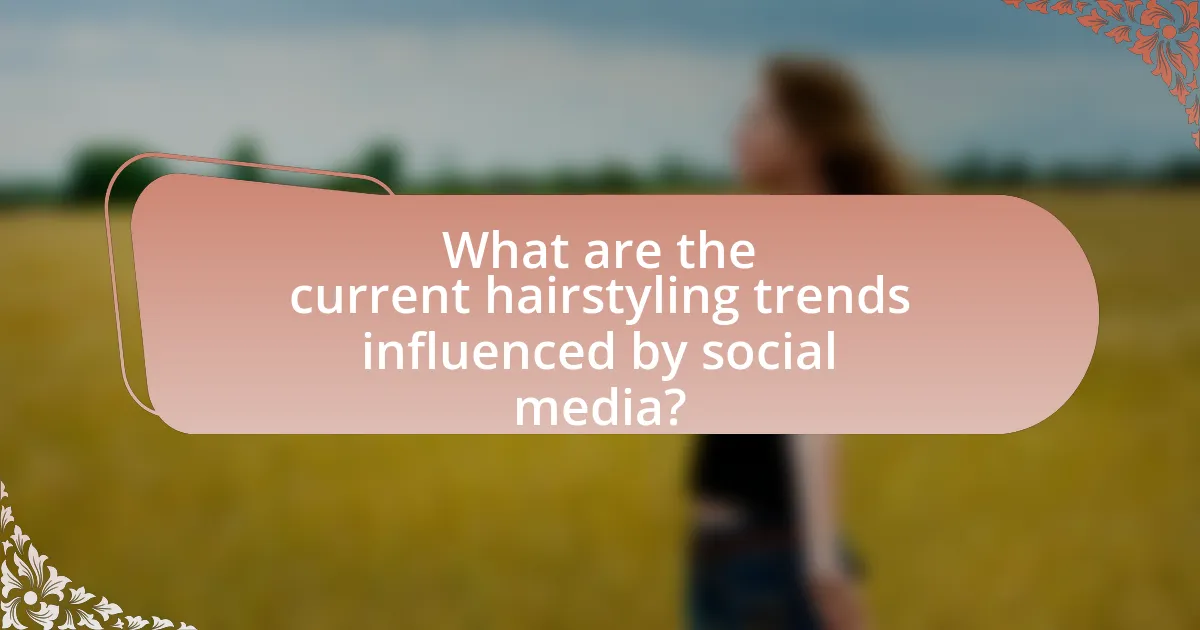
What are the current hairstyling trends influenced by social media?
Current hairstyling trends influenced by social media include the rise of natural textures, bold colors, and vintage-inspired styles. Social media platforms like Instagram and TikTok showcase diverse hair types and encourage authenticity, leading to increased popularity of hairstyles that embrace natural curls and waves. Additionally, vibrant hair colors, such as pastel shades and neon highlights, have gained traction through viral challenges and influencer endorsements. Vintage styles, including 90s-inspired updos and curtain bangs, are also trending as users share nostalgic looks. These trends reflect the power of social media in shaping contemporary hairstyling preferences and promoting individual expression.
Which specific hairstyles have gained popularity through social media?
Hairstyles such as the messy bun, beach waves, and curtain bangs have gained significant popularity through social media platforms like Instagram and TikTok. The messy bun, characterized by its effortless and casual look, has been widely shared in tutorials and influencer posts, making it a go-to style for many. Beach waves, known for their relaxed and tousled appearance, have been popularized by beauty influencers demonstrating easy styling techniques. Curtain bangs, which frame the face and add softness, have seen a resurgence due to viral trends and celebrity endorsements on social media. These hairstyles reflect the influence of visual platforms in shaping contemporary beauty standards and trends.
What are the characteristics of trending hairstyles on platforms like Instagram?
Trending hairstyles on platforms like Instagram are characterized by their emphasis on individuality, creativity, and visual appeal. These hairstyles often incorporate bold colors, unique cuts, and intricate styling techniques that stand out in photos. For instance, the popularity of pastel shades and vibrant hues reflects a desire for self-expression, while styles like curtain bangs and textured bobs showcase versatility and modernity. Additionally, the influence of influencers and celebrities on Instagram drives trends, as their styles are quickly replicated by followers, creating a cycle of inspiration and adaptation. This dynamic nature of social media allows for rapid shifts in trends, making hairstyles not only a form of personal expression but also a reflection of current cultural movements.
How do viral challenges impact hairstyling trends?
Viral challenges significantly influence hairstyling trends by rapidly disseminating new styles and techniques through social media platforms. These challenges often encourage users to showcase their creativity, leading to the adoption of unique hairstyles that gain popularity among a wide audience. For instance, the “Ice Bucket Challenge” not only raised awareness for ALS but also inspired participants to experiment with bold hairstyles, which were then shared widely, creating a ripple effect in hairstyling trends. The immediacy and visual nature of platforms like TikTok and Instagram allow these trends to spread quickly, often resulting in a surge of interest in specific styles, such as colorful hair dyes or intricate braiding techniques.
How do different demographics engage with hairstyling trends on social media?
Different demographics engage with hairstyling trends on social media through varied platforms and content types that resonate with their preferences. For instance, younger audiences, particularly Gen Z, predominantly use TikTok and Instagram to share and discover hairstyling trends, often participating in viral challenges and tutorials that emphasize creativity and individuality. In contrast, older demographics, such as Millennials and Gen X, may prefer Facebook and Pinterest, focusing on curated content and inspiration boards that highlight classic styles and professional advice.
Research indicates that 60% of Gen Z users follow beauty influencers on social media, which significantly influences their hairstyling choices, while 45% of Millennials report using social media for hairstyling inspiration, according to a survey by Statista in 2022. This data underscores the distinct ways in which different age groups utilize social media to engage with hairstyling trends, reflecting their unique cultural contexts and technological familiarity.
What trends are popular among younger audiences compared to older generations?
Younger audiences are increasingly favoring bold and experimental hairstyling trends, such as vibrant hair colors and unconventional cuts, while older generations tend to prefer classic and conservative styles. This shift is largely influenced by social media platforms like Instagram and TikTok, where younger users showcase and popularize unique hairstyles, leading to a rapid spread of trends. For instance, a survey by the Pew Research Center in 2021 indicated that 71% of younger adults use social media for style inspiration, compared to only 30% of older adults, highlighting the significant impact of social media on the hairstyling preferences of younger generations.
How does cultural background influence hairstyling trends on social media?
Cultural background significantly influences hairstyling trends on social media by shaping aesthetic preferences, techniques, and the symbolism associated with different hairstyles. For instance, individuals from diverse cultural backgrounds often share traditional hairstyles that reflect their heritage, such as braids in African cultures or intricate updos in Asian cultures, which gain visibility and popularity on platforms like Instagram and TikTok. This visibility can lead to a broader acceptance and appreciation of various styles, as evidenced by the rise of hashtags like #ProtectiveStyles and #AsianHair, which promote cultural hairstyles and educate audiences about their significance. Furthermore, studies indicate that social media serves as a platform for cultural exchange, allowing users to adopt and adapt styles from different backgrounds, thereby creating hybrid trends that reflect a blend of influences.
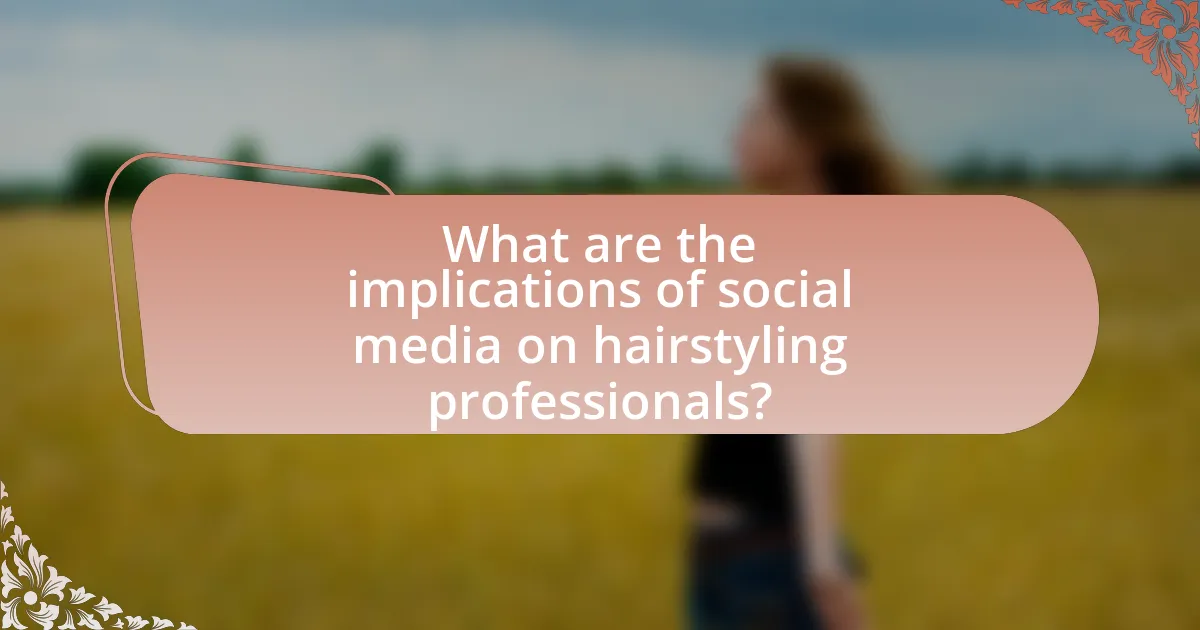
What are the implications of social media on hairstyling professionals?
Social media significantly influences hairstyling professionals by enhancing their visibility and client engagement. Platforms like Instagram and TikTok allow hairstylists to showcase their work, attract new clients, and build personal brands. According to a survey by the Professional Beauty Association, 70% of beauty professionals reported that social media is their primary marketing tool, demonstrating its critical role in client acquisition and retention. Additionally, social media trends often dictate hairstyle popularity, compelling hairstylists to stay updated with current styles to meet client demands. This dynamic creates a competitive environment where hairstylists must continuously adapt their skills and marketing strategies to thrive.
How has social media affected the marketing strategies of hairstylists?
Social media has significantly transformed the marketing strategies of hairstylists by enabling them to showcase their work visually and engage directly with clients. Platforms like Instagram and Facebook allow hairstylists to post before-and-after photos, tutorials, and client testimonials, which enhances their visibility and attracts new customers. According to a survey by the Professional Beauty Association, 70% of beauty professionals reported that social media is their primary marketing tool, demonstrating its critical role in client acquisition and retention. This shift has led hairstylists to adopt targeted advertising and influencer partnerships, further amplifying their reach and establishing their brand identity in a competitive market.
What are the best practices for hairstylists to leverage social media?
Hairstylists can effectively leverage social media by consistently posting high-quality images of their work, engaging with followers, and utilizing relevant hashtags. High-quality images attract potential clients and showcase hairstylists’ skills, while engagement fosters community and loyalty. According to a survey by the Professional Beauty Association, 70% of clients choose their hairstylist based on social media presence, highlighting the importance of visibility. Additionally, using hashtags like #HairGoals or #Hairstylist can increase discoverability, as posts with at least one hashtag receive 12.6% more engagement than those without.
How can hairstylists build their brand through social media platforms?
Hairstylists can build their brand through social media platforms by consistently showcasing their work, engaging with their audience, and utilizing targeted advertising. By posting high-quality images and videos of their hairstyles, hairstylists can attract potential clients and demonstrate their skills. Engaging with followers through comments, direct messages, and interactive content like polls or Q&A sessions fosters a sense of community and loyalty. Additionally, targeted advertising on platforms like Instagram and Facebook allows hairstylists to reach specific demographics, increasing their visibility and client base. According to a survey by Statista, 54% of social media users use these platforms to research products and services, highlighting the importance of a strong online presence for hairstylists.
What challenges do hairstylists face due to social media trends?
Hairstylists face several challenges due to social media trends, primarily including unrealistic client expectations and the rapid pace of trend changes. Social media platforms often showcase highly edited and curated images, leading clients to expect results that may not be achievable on their hair type or condition. Additionally, trends can shift quickly, requiring hairstylists to constantly update their skills and knowledge to meet client demands. According to a survey by the Professional Beauty Association, 70% of hairstylists reported feeling pressured to replicate viral styles, which can lead to burnout and dissatisfaction in their work.
How do unrealistic beauty standards on social media affect hairstyling practices?
Unrealistic beauty standards on social media significantly influence hairstyling practices by promoting specific, often unattainable looks that individuals feel pressured to replicate. This pressure leads to increased demand for hairstyles that align with these idealized images, resulting in trends that prioritize perfection over individuality. For instance, a study published in the Journal of Adolescent Health found that exposure to idealized beauty images on platforms like Instagram correlates with higher levels of dissatisfaction with one’s appearance, which in turn drives consumers to seek out hairstyling services that promise to achieve these standards. Consequently, hairstylists may adapt their techniques and offerings to cater to these trends, often emphasizing styles that are heavily filtered or edited in social media portrayals, thereby perpetuating the cycle of unrealistic expectations.
What are the risks of following social media trends without proper knowledge?
Following social media trends without proper knowledge poses significant risks, including the potential for misinformation and harmful practices. Individuals may adopt hairstyles or techniques that are not suitable for their hair type or health, leading to damage or adverse reactions. For instance, the trend of using certain hair products without understanding their ingredients can result in allergic reactions or scalp issues. Additionally, trends often promote unrealistic beauty standards, which can negatively impact mental health and self-esteem. A study published in the Journal of Adolescent Health found that exposure to idealized images on social media correlates with increased body dissatisfaction among young people. Therefore, engaging with social media trends without adequate knowledge can lead to both physical and psychological harm.
What practical tips can hairstylists use to stay relevant in the age of social media?
Hairstylists can stay relevant in the age of social media by actively engaging with their audience through consistent content creation and showcasing their work. Regularly posting high-quality images and videos of hairstyles on platforms like Instagram and TikTok can attract new clients and retain existing ones. Additionally, hairstylists should utilize trending hashtags and participate in challenges to increase visibility. According to a study by the Pew Research Center, 69% of adults in the U.S. use social media, highlighting its importance for reaching potential clients. Engaging with followers through comments and direct messages fosters community and loyalty, further enhancing a stylist’s relevance in a competitive market.
